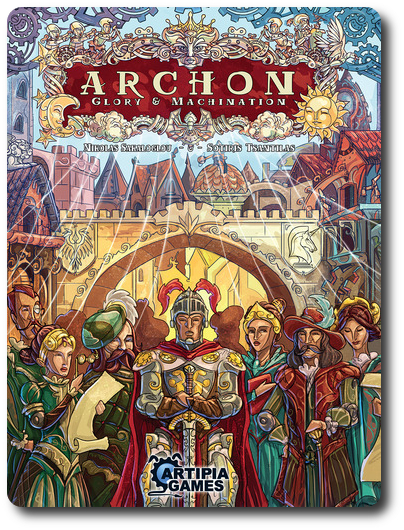
The Basics:
- For ages 11 and up (publisher suggests 12+)
- For 2 to 4 players
- Approximately 120 minutes to complete
Geek Skills:
- Counting & Math
- Logical & Critical Decision Making
- Pattern/Color Matching
- Strategy & Tactics
- Hand/Resource Management
- Worker Placement & Area Control
Learning Curve:
- Child – Moderate
- Adult – Easy
Theme & Narrative:
- True power comes from the masses that support you
Endorsements:
- Gamer Geek approved!
- Parent Geek mixed!
- Child Geek rejected!
Overview
The great city of Cardis is the home of the kingdom’s trade and culture. It’s for this reason the King has appointed several archons to govern and protect the city so it might flourish and benefit the realm. But an archon cannot rule a city alone. They must get help from influential Magisters and earn the trust of the people. Easier said than done.
Archon: Glory and Machination, designed by Nikolas Sakaloglou, Sotirios Tsantilas, and published by Artipia Games, is comprised of 1 game board, 56 Magister cards, 32 Courtier cards, 20 wooden figures (stylized meeples), 24 wooden discs (used as markers), 60 wooden cubes (used a resources), 6 King’s Grant cards, 22 King’s Favor cards, 20 “1 Value” Gold Coins, 7 “5 Value” Gold Coins, 6 Attack cards, 16 Tax Collector tokens, 25 Recruit tokens, 23 Building tiles, 1 Season Track token, 4 60-Victory Point tiles, 9 Action Cover tokens, 23 Science cards, 23 Arts cards, 20 Elite Warrior cards, 20 Province cards, and 12 Player Aid cards. The cards are as thick and as durable as your standard playing card. The game board and tokens are made of thick cardboard. The illustrations by artists Antonis Papantoniou and Giota Vorgia play well to the game’s theme, portraying the people and personalities as clockwork automatons or puppets. Where joints would normally be, are gears, strings, and hinges, for example. The end result is a game that looks impressive and is highly stylized.
Note: The white and tan wooden pieces look very similar to each other in color under certain light. This caused a great deal of confusion during our first game. We easily fixed this by adding a single black dot to all the white pieces (cubes and meeples) using a permanent marker.
Game Set Up
To set up the game, first place the game board in the middle of the playing area. The game board is large, so make sure you have a large playing area available.
Second, give each player 5 wooden figures, 6 markers, 5 Elite Warrior cards, and 8 Courtier cards in the colors and emblems of their choice.
Third, randomly determine the first turn order using whatever method the group likes. Player order is recorded on the Player Order track found on the game board under the “Palace” section.
Fourth, give the players their starting resources and Gold. The amount provided is based on the player’s order. For example, the first player will be given 1 grey wooden cube (which represents Silver), 2 “1-Value” Gold Coins, and 1 Recruit token while the third and fourth players in the game are both given 1 grey wooden cube, 2 “1-Value” Gold Coins, and 2 Recruiter tokens.
Fifth, place all the wooden cubes in the “Repository” section of the game board that looks like a building. Each cube is a different color and represents a different resource. As already noted, grey represents Silver. The other colors include tan (Papyrus), white (Stone), and black (Iron).
Sixth, shuffle the Province cards and place them face-down in an area reserved for the cards under the “Repository” section on the game board to create the Province draw deck. Draw the first Province card and fill the area with the resources noted. The specific number used is based on the number of players.
Seventh, shuffle the King’s Grant cards and place the first 3 card face-up on top of the “Palace” section on the game board. The remaining King’s Grant cards are returned to the game box. Now fill the “Marketplace” Section with the resources indicated on the first King’s Grant card drawn.
Eighth, each player now places 1 of their markers on the “4” space of the Scoring track located on the borders of the game board. Then the players place their remaining markers (4 in total) on each of the starting square spaces of the Magister track found on the game board.
Ninth, separate the Magister cards into 4 face-up piles based on their type (Merchants, Scribes, Clerics, and Tax Collectors). The piles should be placed next to the “Guild Hall” section of the game board, but off to one side.
Tenth, in turn order sequence each player must now acquire 2 different Magisters by paying the cost indicated on the space their marker is on. This is done by moving the marker on the track to the right, paying the cost, and then taking the Magister card. The two cards acquired go into the player’s hand with their Courtier cards. Do not add the victory points at this time (that has already been done on the Scoring track).
Eleventh, place the Science cards face-up next to the “Planetarium” section and the Arts cards face-up next to the “Academy” section of the game board.
Twelfth, shuffle the Attack cards and place them face-down in their designated area to create the Attack draw deck.
Thirteenth, sort all Building tiles by name. Then place the tiles on their corresponding building section, face-up. If only playing with 2 players, only 1 tile per building should be used with the rest returned to the game box.
Fourteenth, shuffle the King’s Favor cards and place them on the “Palace” section of the game board, followed by 1 additional King’s Favor card per player using the space indicated by the arrows. Place any not used face-down to be drawn later in the game.
Fifteenth, place the Season Track token on the 1st square space found on the Season track on the game board, the remaining Recruit tokens in the “Barracks” section, and place all the remaining Gold Coins on top of the “Treasury” section found on the game board.
Holy cow! That’s a lot of set up, eh? It will take you some time to set up the game until you understand how it’s played. The game might have a lot of bits, but the majority of your set up time will be spent separating them instead of placing them. You can reduce your set up time by storing the game bits into different bags.
That’s it for game set up. Time to take over the hearts and minds of the city.
The Workings of Man
Archon: Glory and Machination is played in turns and rounds. Every three rounds is called a “Season”. At the end of each Season, the city (and the players) are attacked.
Prior to starting the first round of game play, each player should separate their Courtier and Magister cards into two piles of 5 cards each. The player can organize the two piles however they choose. One of the two piles will be used during the first round of game play and then the other. After the second pile is used, the players again organize their cards into two different piles. The Season Track has icons that help the players to remember when they need to split their cards.
In turn order sequence, each player will play 1 or more cards from their hand and place 1 wooden figure on an available Action Slot. Depending on the number of players, the available Action Slots might be reduced fairly quickly. The Action Cover tiles should be used to cover up those Action Slots not used in the game. Some Action Slots only require the player to use 1 card of any type, while other Action slots will require the player to play either 2 Courtiers or 1 of any Magister card.
Once the wooden figure is placed on the Action Slot, the player immediately resolves the associated action.
The city of Cardis has a great deal to offer the players as far as actions go. The sections represent different buildings and areas of the city where the player can acquire power and prestige through influence and negotiation. Think of the city as the player’s toolbox. Everything the player needs to win is available to them, but they must figure out how best to use it.
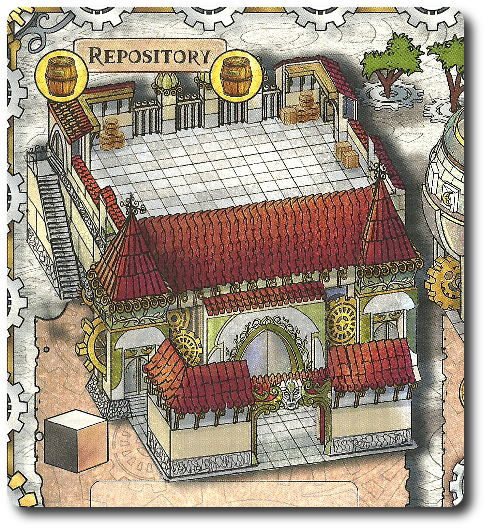
Each of the actions are summarized here.
- Repository: acquire resource cubes
- Barracks: acquire Recruit tokens
- Treasury: acquire Gold Coins
- Marketplace: purchase or sell resources
- Guild Hall: pay to acquire a Magister card (newly acquired Magister cards replace Courtier cards)
- Royal Guard: place 1 Elite Warrior card on an available Wall slot to help defend the city
- Builder’s Guild: pay to acquire a Building tile and victory points
- Academy: pay to acquire 1 Arts card
- Planetarium: pay to acquire 1 Science card
- Palace: use 1 King’s Favor card
A player need not play a card if they think it in their best interest to keep what they have. A player may decide to pass on their turn by saying so and announcing to the table how many cards they still have in their hand, but doing so locks them out for the rest of the round. A player must pass if they no longer have any cards in their hand or wooden figures to place on the game board.
After all the players have decided or are forced to pass, the round comes to an end. All players reveal their unused cards. The player with the most unused cards becomes the next round’s first player. The second player is the next player with the second most unused cards and so on until the turn order for the next round has been determined. Ties are broken by determining which player has the highest valued unused card. In cases where a tie cannot be resolved, the players keep their turn order positions.
All cards for the round are then discarded and put to one side. Any Courtier cards that were bumped due to an acquired Magister card are out for the duration of the game. In this way, a player always has no more and no less than 10 cards comprised of Magisters and a dwindling number of Courtiers.
All wooden figures are also removed from the game board, returning to their owner. Tax Collector tokens are also removed from the game board at this time, as is the King’s Favor card that is the furthest along the Palace track. All other King’s Favor cards are shifted to the next position (follow the arrows) and then reveal a new King’s Favor card and place it in the empty slot position.
Finally, any resources located in the “Repository” are returned to the stockpile. A new Province card is drawn to seed the “Repository” again with new resources. If this is the third round of the Season, players combine and then split their cards into 2 decks of 5 cards each.
The Season Track token is then advanced.
Mastering the Magisters
Archon: Glory and Machinations has a light, but important, deck-building game mechanism. At the start of the game, each player has 8 of the same card, the Courtiers. Then each player acquires 2 Magisters which might or might not be the same as the player’s opponents. As the game continues, the players will be swapping out Courtiers with the Magisters. This is important for two reasons.
First, the Magisters are more powerful when it comes to playing cards to grab actions. One Magister card is worth two Courtier cards. Since a player can only have 5 cards per round, filling it with Magisters give the player 5 opportunities to take actions. Through actions, the player will acquire power and influence, which is necessary to earn victory points and win the game.
Second, using Magisters to grab actions, the player can earn a bonus actions.
- Tax Collector: force opponents to pay the player 1 Gold Coin when using an action in the same location as the player’s Tax Collector token
- Scribe: after playing the Scribe to grab an action, take another turn (can only be done once per turn during the round)
- Cleric: take the action regardless if an Action Slot is available or not
- Merchant: sections of the city that show the Merchant symbol give the player extra benefits when completing an action
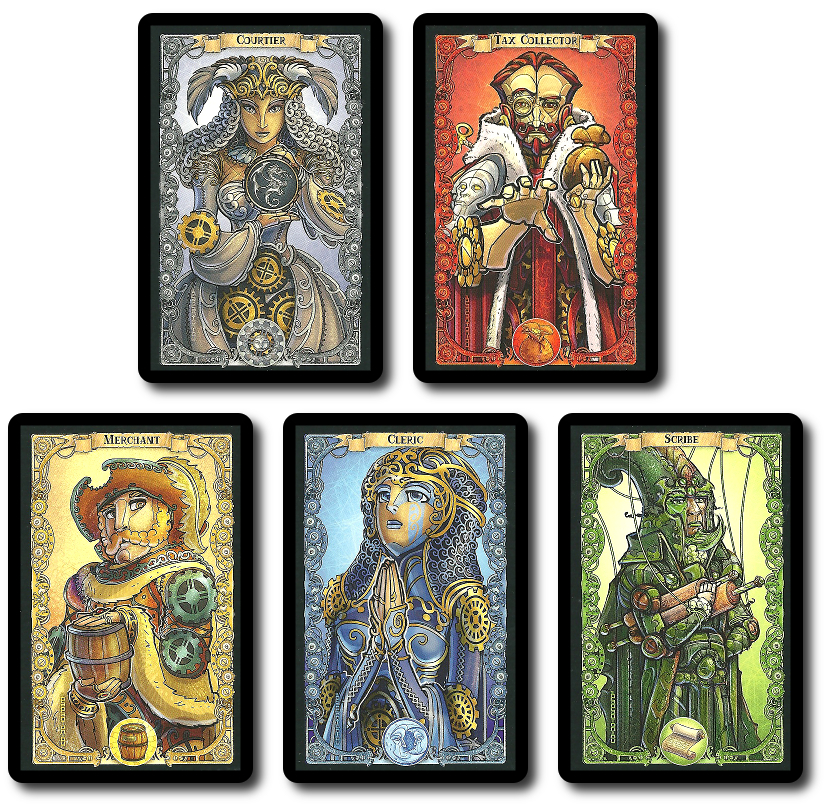
Very powerful, eh? But such power comes at a cost. There are only so many Magister cards to go around and players are limited by the total number of cards they can have and use during each round. This means players will have to carefully consider which cards to invest in because each time the player buys one, they cost more. On the upside, the player earns victory points by investing their time and resources in the city’s most powerful leaders.
Concerning Buildings and the King’s Favor
When a player acquires a building during their turn, they not only earn victory points, but also gain access to additional bonuses and actions. There are, of course, a few rules the player must abide by before they become the owner of city property. A player cannot own anymore than 1 of each Building tile, for example. Which might sound restrictive, but there are a lot of Building tiles to acquire. Acquiring the Building becomes less expensive as the game moves through the Seasons, awarding those who wait for a “buyer’s market”, but the benefits earned by the Building tiles may no longer apply. This forces a player to consider buying a property early and for a lot of Gold in hopes of using the benefits it provides or wait until the cost drops at risk of not gaining anything other than victory points.
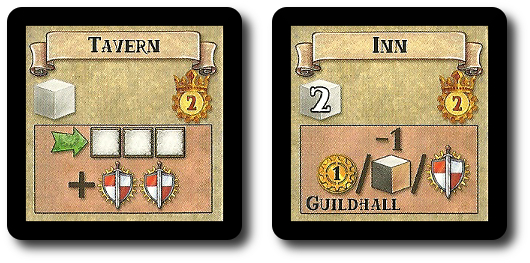
There are 15 different Building tiles in the game. A few of them are noted here, along with their benefits.
- Craftsman: earn 2 Gold Coins each time a new Building tile is acquired
- House of Arts: earn 3 Gold Coins at the start of all future Seasons
- Tavern: acquire 2 Recruit tokens at the start of all future Seasons
- Inn: pay 1 less resource when acquiring a new Magister card
- Armory: earn 1 victory point for each Elite Warrior the player has protecting the city during an attack
- Library: earn 1 victory point for each Science card acquired
The King’s Favor cards provide players additional Action Slots every round, but the available actions to be taken are always changing. At the end of each round, a King’s Favor card will be taken off the game board and a new one will replace it. Each King’s Favor card will only remain available for a certain amount of time, challenging the players to carefully consider if the King’s help is worth grabbing or letting go.
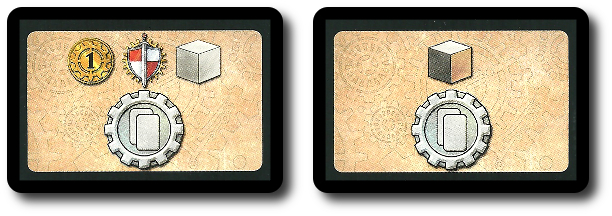
A City Under Siege
The city will come under attack several times during the game. The players will see it coming a mile away thanks to the Season Track identify the end of the round in which the attack will occur.
When an attack does occur, the Attack cards are shuffled and 1 is drawn to reveal the strength of the invaders. The attack strength is based on the number of players in the game.
If the total number of Elite Warriors defending the city’s wall is equal to or greater than the Attack card’s Attack Strength value, the city successfully repelled the invaders. However, if the total number of Elite Warriors is less than the Attack Strength value, then the enemy has breached the walls and swarms the city. Each player must discard 1 Recruit token equal to the difference between the total number of Elite Warriors they provided and the Attack Strength value. If the player is unable to pay the difference using Recruit tokens, they must use resources instead. If they still cannot pay the differences, they must spend 2 Gold Coins per every Attack Strength value they cannot account for using Recruit tokens and resources. Finally, if the player is so bad off that they cannot pay using Recruit tokens, resources, or Gold Coins, they must spend their hard-earned victory points, possibly dropping their score below zero.
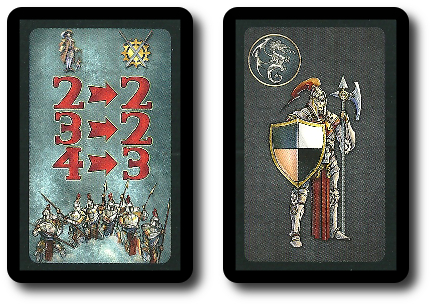
Gaining Power Among the People
After the city has successfully avoided an attack or suffered the devastation of poor defensive planning by the players, the game is scored. The number of victory points scored is determined by the current Season’s King’s Grant card. Players with the most items noted on the card scores the most points, followed by the second highest, and so on. In this way, players know what will be scored and how many points they are worth during the previous Seasons. This is why players acquire cards and resources. The requirements to earn the most points are clearly visible, but how best to acquire them is purposely ambiguous and part of the challenge. Players will also earn victory points along the way, making some actions more enticing than others.
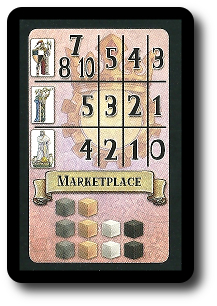
The Season now comes to an end. The King’s Grant card is turned face-down and the Marketplace is then filled based on the new King’s Grant card.
The city is now at peace and all the Elite Warrior cards hang up their swords and shields, returning to their owners. Since the city is no longer threatened, the artists and scholars return to their work, releasing any acquired Science and Art cards back to their respective piles.
A new round now begins as previously noted above.
A City of Your Own
The game comes to an end after the scoring is completed during the third and final Season. Players add up any remaining victory points earned by Building tiles and record them on the Scoring track. The player with the most victory points is the winner and now has total control over the city and the full trust of the King.
To learn more about Archon: Glory and Machination, visit the game’s web page.
Final Word
The Child Geeks were overwhelmed from the very start. It took a number of game playing session to complete one game and we lost a few players along the way. Those who remained were either familiar with and had played larger games before or simply didn’t have anything better to do. According to one of the veteran Child Geeks, “This is a really challenging game, but I don’t think it’s hard. Pretty much everything you need to know is always in front of you.” The game does tell you a lot, and depending on how you are interpreting the game, that can be a clear message or garbled static. According to another Child Geek, “I know how to play, but I never know what to do. There’s too much to do. And I don’t know what I should do first.” This can be very frustrating, even to Gamer Geeks. The game opens its doors wide to the players from the very start, keeping little out of reach. While empowering, it can make one feel like they are drowning in options. When all the games were over, only the elite Child Geeks approved the game. Archon failed to receive the Child Geek endorsement. Color me not surprised.
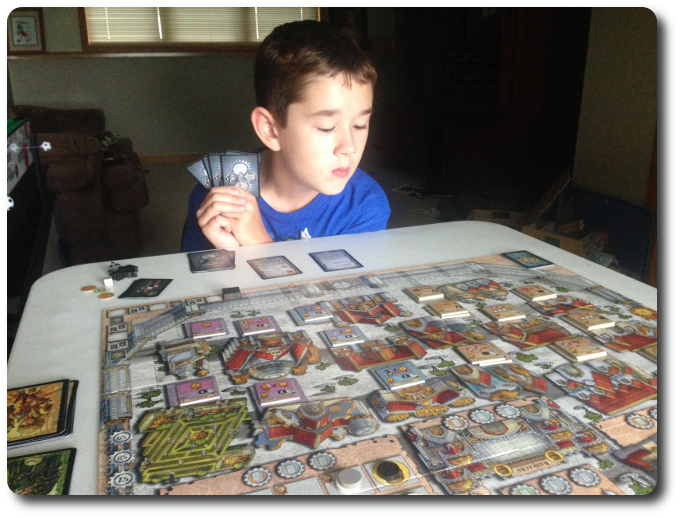
The First Player has unlimited options, which can be very intimidating
The Parent Geeks had a lot of the same problems as the Child Geeks. This group is primarily comprised of casual gamers and non-gamers, with a small but growing number of veteran gamers. For those Parent Geeks who had played many games before, Archon was a game they quickly learned and were able to play without issue. The casual gamers had more trouble, due to the many options and lack of hints concerning what should be focused on. The non-gamers were scared stiff. According to one non-gamer Parent Geek, “This is the very definition of a big game I do not want to play. Anything that takes up most of my kitchen table to play is not a game I want to sit down to.” A casual gamer Parent Geek said, “This is a challenging game at first. While I found it easy to learn, I struggled for about half the game until it all came together. When it did, I really enjoyed myself.” And finally, a veteran gamer Parent Geek said, “A solid game. A fascinating game. A great game. I really enjoyed it. Too bad it takes so long to play. I doubt I’d be able to play it more than once a year.” When all the votes were counted, the Parent Geeks gave Archon a mixed approval.
The Gamer Geeks quickly learned and jumped into the game. I love watching Gamer Geeks play games. I can see their minds and fingers working in tandem as they move, shift, and attempt to control or break the game in front of them. None of the Gamer Geeks broke the game, but many of them found themselves scratching their heads wondering if they had missed something. According to one Gamer Geek, “I keep thinking you didn’t teach the game right. It feels like the game play is too easy compared to the very complex impact each action has on the game.” This Gamer Geek nailed it. Archon is a game that makes it very easy to do a lot of things that are all possibly very important. The value of the action, however, is based on the player’s strategy and tactics. Another Gamer Geek said, “There are many things about this game I like and some that I find frustrating. Overall, an excellent mix of the two. This is a game I would gladly play again.” The Gamer Geeks all agreed that Archon: Glory and Machination was a game that was not perfect, but was also a great time. They approved Archon with a round of applause.
Archon: Glory and Machination is an interesting and challenging game. At no time did I ever feel confused about what I needed to do, but I was always left wondering if I was taking the best path. A player is given a great deal of freedom, but is also limited. The limits are set by the number of cards the player has in their hand and the available Action Slots. A player can bend these limitations, but not break them. Everything is firmly anchored to how many cards, wooden figures, and Action Slots are available. This made each turn a problem to solve and an exercise is some very critical thinking. All the while, the overall goal of the game is pretty straight forward: earn points. The game’s real joy comes in the many tactical ways a player can get there using a wide variety of strategies.
This game will not be for everyone and I doubt any but serious gamers will sit down and play it. That game board is large and busy, making the first game feel a bit daunting to new players and non-gamers. Even Gamer Geeks are a bit overwhelmed at first when they see all there is to do and work with during the game set up. But I encourage all to try the game. As big and as busy as the game may seem, game play is very straight forward. What many players initially miss due to the amount of bits on the table is how much information the game is providing. Players always know how to make points and when points will be taken away. Archon is a game that wants you to win because it gives you everything but a road map to succeed. It’s up to the players to read the sign and travel the path.
My favorite aspect of the game is also the most subtle. The light deck-building mechanism was a lot of fun. Everyone starts with the same followers represented by the cards. They are good at their job, but lack specific skills. By collecting Magisters, a player not only strengthens their hand, but opens new opportunities and bonuses. I was surprised how little attention was given to this aspect of the game at first since the differences between a good round and a bad round oftentimes came down to what cards you had in your hand. Players will not be able to collect all the Magisters, so careful planning and critical thinking is necessary.
Here is a game that will challenge and reward a player. There is a lot to review and to consider, but the game’s bulk is streamlined and contained, making a very big game feel manageable. That won’t stop a player from feeling intimidated, however, and I do not recommend this game to anyone who has not played larger and more complex games in the past. The rules are straight forward which will make the game easy to learn, but it’s the abundant amount of options and actions available to the player in the game that is going to make many feel confused and frustrated. If you are the type of player who likes a game that gives you control, including the ability to shoot yourself in the proverbial foot, then do play Archon: Glory and Machination. It’s a jewel of a game that I have yet to beat, but continue to enjoy.
This game was given to Father Geek as a review copy. Father Geek was not paid, bribed, wined, dined, or threatened in vain hopes of influencing this review. Such is the statuesque and legendary integrity of Father Geek.



